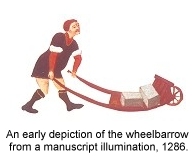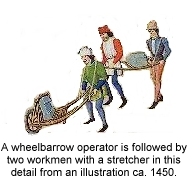
Gothic Design
Learn More.
| HOME Feature Articles Stone Carver's Tour Virtual Cathedral Cathedral Tours Gothic Field Guide GOTHIC GEOMETRY Virtual Abbey Medieval Art Tours Castle Tours Links Resources About The Site FAQ |
|
A huge leap in a better design, however, finally made its appearance in Europe sometime in the 13th century. By this time, the wheelbarrow had grown long, graceful arms for handles, and the wheel was now pitched forward giving operators a center of gravity and a smoother ride. Before wheelbarrows, stretchers were commonly used to move heavy materials around , but this required at least two men on either end to carry the weight. The wheelbarrow, which needed only one operator, helped free up manpower for other jobs on medieval construction sites.
Who invented the wheelbarrow? Nobody knows for sure. Taking into account the back-breaking labor of moving heavy timbers and stone required on major projects, all evidence points to a bone-weary construction worker.
|
Sponsored
Links
copyright © 2017
 While
the Chinese are credited for the first wheelbarrow in 100 AD, it
was basically a box with a wheel underneath. It must have been a
clunky affair, and hard to maneuver over rough terrain.
While
the Chinese are credited for the first wheelbarrow in 100 AD, it
was basically a box with a wheel underneath. It must have been a
clunky affair, and hard to maneuver over rough terrain.
 So
could the wheelbarrow be credited for helping to speed the construction
of the great cathedrals and castles of the era? Possibly. Yet the
stretcher was still being used together with the wheelbarrow as
late as the mid-15th century as seen in the illustration, right.
So
could the wheelbarrow be credited for helping to speed the construction
of the great cathedrals and castles of the era? Possibly. Yet the
stretcher was still being used together with the wheelbarrow as
late as the mid-15th century as seen in the illustration, right.